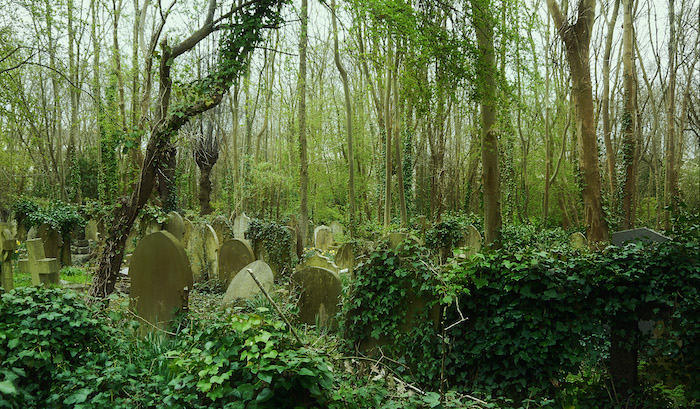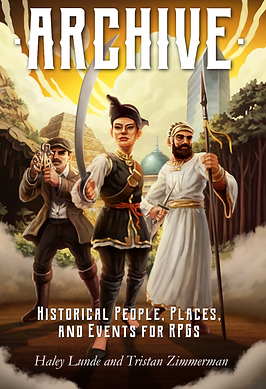Once a month here on the Molten Sulfur Blog, I run content taken from our book Archive: Historical People, Places, and Events for RPGs. This post is one of eighty entries in Archive, each more gameable than the last!
This post is brought to you by beloved Patreon backer Colin Wixted. Thanks for helping keep the lights on! If you want to help keep this blog going alongside Colin, head over to the Patreon page – and thank you!

Highgate Cemetery
Home of the (Un)dead
Highgate Cemetery in north London was opened in 1839. It is separated into an East Cemetery and West Cemetery by a road cutting through it. East Cemetery is open daily and can be visited for a small fee. It’s known for its famous residents, including Karl Marx. West Cemetery is only accessible to those who have scheduled a tour. West Cemetery is known for its intricate Victorian architecture, but the area’s age has left some of the ground unsafe. While visitors are attracted to the cemetery to both mourn and celebrate the departed, in the early 1970’s, rumors flooded north London of a vampire roaming the graveyard.
Most people visit the overgrown East Cemetery to see its resting residents. The monument marking Karl Marx’s grave attracts not only sightseers, but also future neighbors. Prominent communists buried nearby include Yusuf Dadoo and Claudia Jones. Pop artist Patrick Caulfield also rests in Highgate Cemetery, his grave marked by a sleek tombstone with the letters D E A D punched through it, designed by Caulfield himself. Mary Ann Cross, who wrote under the pseudonym of George Eliot, has her plot among friends and associates.
West Cemetery is home to some of the most impressive architecture in Highgate. A chapel squats beside the main entrance, towering archways and silent rooms beckoning. It’s occasionally used for funerals, meetings, and concerts. The main path through West Cemetery opens out suddenly in front of an Egyptian gateway flanked by obelisks. This is Egyptian Avenue, the architecture inspired by popular interest in ancient Egypt during the cemetery’s founding. Tombs line the avenue and encircle the massive cedar tree at its end. Some have Egyptian influence, but many are classic, with intricate borders on their memorials, stone crosses, or angels watching nearby. This area is known as the Circle of Lebanon. Beneath are brick catacombs holding the corpses of those whose plots aren’t ready.
While the cemetery is beautiful during the day, at night, Highgate becomes a hotspot for ghost sightings, especially in the portions that have fallen into disrepair. These sightings and rumors of occult activity began in earnest in 1963 when a couple walking at night down the road dividing the East and West cemeteries claimed to see a tall, dark figure floating behind the gate railings, with a terribly distorted face. More sightings followed. People took to calling the figure the ‘Highgate Vampire’. By 1969, the rumors attracted two young men who would become rivals: David Farrant, a young Wicca enthusiast and member of the British Occult Society, and Sean Manchester, an eccentric and flamboyant fellow claiming to be a bishop in an obscure church.
Farrant spent a night in Highgate Cemetery in December of 1969, and he claimed to have witnessed a tall, dark figure, with hypnotic eyes. The local newspaper had become interested in the sightings, including some reports of Satanists performing black magic and animal sacrifice at the cemetery. This attracted ‘Bishop’ Sean Manchester, who claimed to be a vampire hunter. In an interview, Manchester said the figure was a ‘King Vampire’, an undead 15th century Romanian nobleman who had practiced black magic in the home of Dracula, and while traveling to England had somehow ended up buried in Highgate and revived by Satanist activity. In 1970, Farrant and Manchester were both interviewed about the sightings, and sparked what would be known as the legend of the Highgate Vampire.
After their interview, Manchester and Farrant led a vampire hunt that very night. Mobs of people joined in, and though they failed to find, much less stake, a vampire, several more people reported seeing the figure on the grounds. The search did not end with a single failed hunt. Farrant was even arrested later near the cemetery carrying a crucifix and a wooden stake. The two maintained their rivalry by publishing numerous books about the affair. In 1985, Manchester self-published a book in which he sensationally claimed to have hunted the vampire for 13 years before finally staking, beheading, and burning it.
Highgate Cemetery in Play
The overgrown Gothic ostentation of Highgate makes it a perfect cemetery for games. PCs could hunt the vampire, investigate reports of Satanic rituals and sacrifices, or try to stop a communist necromancer from raising Karl Marx and company. The party’s inquiries could identify a gang of masked pranksters as being behind a rash of sightings, only to have the real Highgate Vampire appear during the reveal scene. Mundane evil organizations might be operating in Highgate under the cover of folklore. Any odd sightings in the cemetery will be misattributed to ghouls or Satanists. If the PCs are doing something serious in Highgate, you could complicate their activities by introducing bumbling rivals Manchester and Farrant, possibly even at the head of a mob of enthusiastic vampire hunters.
–
Come follow and chat with me on social media! On Twitter, I’m @moltensulfur. On Facebook, I’m Molten Sulfur Press.






